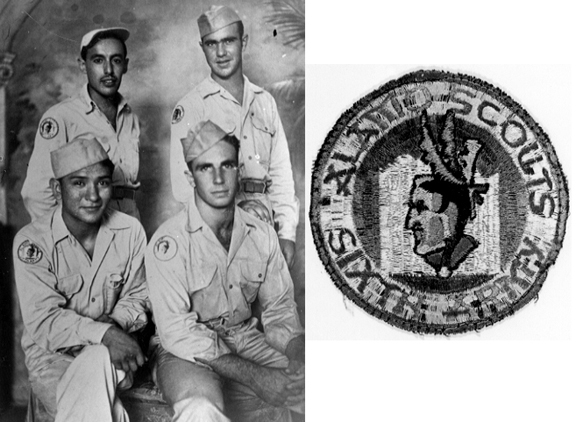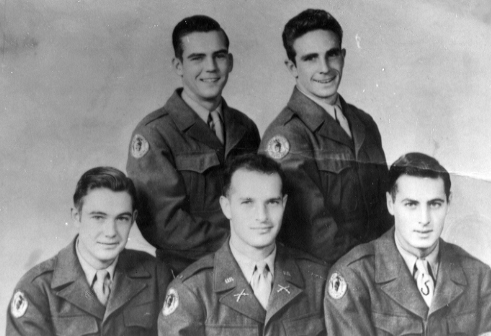|
|
The Alamo Scouts Sleeve Insignia by Les Hughes © by author 1986 |
|
|
|
Sometime
during the fall of 1944, a contest was held at the ASTC (Hollandia,
Dutch New Guinea) to choose a suitable design for a Scout sleeve patch.
The winning design was submitted by CPL Harry Golden, a medic
assigned to the ASTC; $15 was the prize for his effort.1
Golden's design features the head of an Indian in profile,
representing silent reconnaissance, superimposed on the Alamo. The patch
was not authorized by the Army (the unit’s size and status would not
have justified its own patch, and The Institute of Heraldry would never
have approved the design), but it was approved, by General Krueger, for
wear in Sixth Army by ASTC graduates, staff, and overhead personnel.2
The approved manner for wearing the patch was on the right sleeve or
left breast. To finance the patch purchase, all officers (Scouts and ASTC staff) were assessed five dollars; the EM nothing. A money order was purchased, and an order for the patches was submitted to N. S. Meyer, Inc., in New York. Although documentation regarding the purchase no longer exists, either among the Scouts or at N. S. Meyer, the best estimate is that 440 patches were ordered.3 Early in 1945 (probably in April), the patches were received and distribution began. The original artwork of CPL Harry Golden (left) and the Meyer-made patch based on it. It
was the recollection of COL Robert S. Sumner, who, as a lieutenant, had
been a Scout team leader, that those receiving patches were assessed 10¢
per patch, and that each officer and EM on operational teams received
three or four; other members of the ASTC cadre received two or three. A
document that has since surfaced appears to contradict aspects of what
COL Sumner recalled.4 The document is a letter, dated March 1945,
that was sent to about 50 former Scouts and ASTC staff and overhead
personnel, offering them the opportunity to acquire the Alamo Scouts
sleeve insignia when they were available (probably in April, the letter
noted). The letter specified a charge of 50¢ per patch, and it
speculated that a limit of ten patches per man might be imposed. A limit
of ten patches per man is puzzling: if, in fact, 440 patches were
ordered from Meyer, then, in principle, the entire order could have been
exhausted by requests from personnel no longer at the ASTC. Indeed, a
supply of 440 patches nearly would have been exhausted if each of the
143 Scouts had taken three, leaving almost none for the overhead
personnel, who numbered about 110. My suspicion is that few individuals
took more than three patches, and most just one or two.
Four recent graduates of the ASTC's eighth class display their locally-made patches. A detailed image of one of these patches is illustrated. (A. Bethel) Lewis
Hochstrasser (then a captain and the unit's S-1) recalls making the
final distribution of patches in the Philippines around August 1945,
just before he returned to the States on points rotation, which suggests
the supply of patches lasted about four months. Support for
Hochstrasser’s recollection came from a member of the eighth class
(which graduated on 28 July 1945), who recalled being told there were no
Scout patches available. As a result, he and a group of graduates
procured locally-made examples.
The team of LT H. L. Adkins (front, center), the last Scout team formed. (C. Bertoch) On the other hand, it appears that the Meyer-made patches were available to Scouts of the ninth class, though by what mechanism one can only speculate. Training of the ninth, and final, class was cut short by two weeks by the surrender of the Japanese. Nevertheless, one Scout team, under Lt. H. L. Adkins, was formed from the class, and, with other Scouts, served as General Krueger's personal honor guard in Japan.5 One can imagine the high-profile nature of such a role motivating the ASTC staff to provide the team with patches.
In
1963 a brief article on the Alamo Scouts appeared in The Trading Post,
the quarterly journal of the American Society of Military Insignia
Collectors.6
The
article contained several factual errors regarding the Scouts, but the
most unusual aspect of the article, where insignia are concerned, is
this statement: "the unofficial insignia of the Alamo Scouts is a
tomahawk shown above [referring to a drawing in the article] worn on the
left breast pocket." The
statement is especially bizarre in light of the fact that the article
made no mention whatsoever of the Scout patch. I
first learned of the existence of the tomahawk badge was during a
conversation with the late Jay Massaro, a respected collector of
distinctive unit insignia, who, upon hearing that was I researching the
Scouts, asked if the badge was legitimate.
When I told Jay that I was unfamiliar with the badge, he
referenced the 1963 article, and he provided me with the name of a collector who
was interested in the Scouts and was familiar with the
badge. I
asked Col. Robert Sumner, Director of the Alamo Scouts Association, and
his response was swift and unequivocal: "There was NEVER any type
of the badge or pin for, or used in any fashion by, the Alamo Scouts.
The patch was the single distinctive item authorized by General
Krueger." I wondered
whether any of the Scouts might have acquired such a badge unofficially,
so I asked Col. Sumner to query members of the Association, which he
did. None of the Scouts was
familiar with the badge. So
much for the tomahawk badge, or so I thought.
I relayed this information to Col. Sumner. His response should give cause to collectors and to those with the desire to conduct historical research. "I encountered several people over the years who claimed membership in the Scouts and had terrific tales to spin. One, a young captain I met in Korea, said he was a platoon leader in Company A! He had come across a Scouts patch, which he wore. They took care of this situation quickly, including his records wherein it was cited that he had service in the Alamo Scouts Battalion. In the past few years, I've had inquiries from lawyers whose clients were suing for VA and or disability compensation from the government - their clients alleging service in the Scouts - and the comments were wild. I've also seen some of the extracts from testimony in depositions; you wouldn't believe some of the things we were alleged to have been or participated in. The names of these people were not at all familiar to any of the located Scouts." Apparently,
researchers, too, have
been duped. In
1982 an article on the Scouts appeared in a military magazine. Using, for the most part, a few Army documents, the author, a serving
Army officer, succeeded in painting an overall picture of the mission
and activities of the Scouts. The
article contained several errors - assertions that the author
attributes, in a footnote, to an interview he conducted with a former
Scout, whom he names. Puzzled
by the fact that he had never heard of this former Scout, Col. Sumner
contacted the author of the article and asked to be put in touch with
the ex-Scout. The author
never responded. In the 25
years that have elapsed since the publication of that article, a
significant effort has been made to identify those who attended the ASTC,
those who were retained as Scouts, and those who served as the ASTC's
staff or overhead personnel. The alleged former Scout cited in the 1982
article cannot be linked to the Alamo Scouts either by the recollections
of former Scouts and ASTC staff or by official records. Believing that the Tomahawk badge might simply be misidentified, I made an effort to see if I could find instances of its used elsewhere. The closest example I could find is a tomahawk patch; not a sleeve patch, but a rectangular patch about the size of a sew-on name strip. Photographs showing this tomahawk patch being worn above the left pocket of the fatigue shirts of several senior officers of the 23rd Infantry Battalion can be found in the book The Second United States Infantry Division in Korea: 1 Jan 53 - 31 Dec 43.7 Finally,
there exists one other "Alamo Scouts" patch that deserves
mention. This patch,
identical to the original in design but without the words "Sixth
Army," is worn by the members of Explorer Scout Troop 412 in St.
Ansgar, Iowa.8 The patch was
the idea of the Troop's adviser, Galen Kittleson.
Kittleson joined the Alamo Scouts as a 19-year-old private from the
503rd PIR and remained with the unit until it was disbanded. As a member of the Nellist Team, Kittleson participated in
missions to free POWs on Cape Oransbari and at the Cabanatuan Prison. And many years later, as a member of Special Forces, Kittleson
participated in the Son Tay Raid. So, in a sense, the Alamo Scouts are alive and well in the
small Iowa community. Endnotes 1. Other designs can be seen at www.alamoscouts.org/special_forces/insignia.htm 2. Although the patch was unauthorized, former Scouts who remained in the Army after WWII wore it on their right sleeve. 3. Col. Robert S. Sumner, private communication. 4. www.alamoscouts.org/pop_ups/patch_order.htm 5. Lance Q. Zedric, Silent Warriors of World War II (Pathfinder Publishing of California. Ventura, 1995). p. 246. 6. LTC W. W. McCracken and A. A. Litman, "The Alamo Scouts." The Trading Post, April/June 1963. 7. Toppan Printing Co., Ltd., Tokyo. Date unknown. 8. This was so when I first wrote this article in 1986, and I would be surprised if it were no longer so. Galen Kittleson died in 2006.
|


